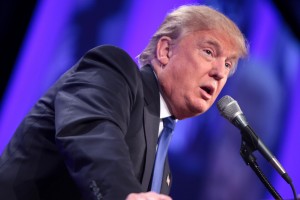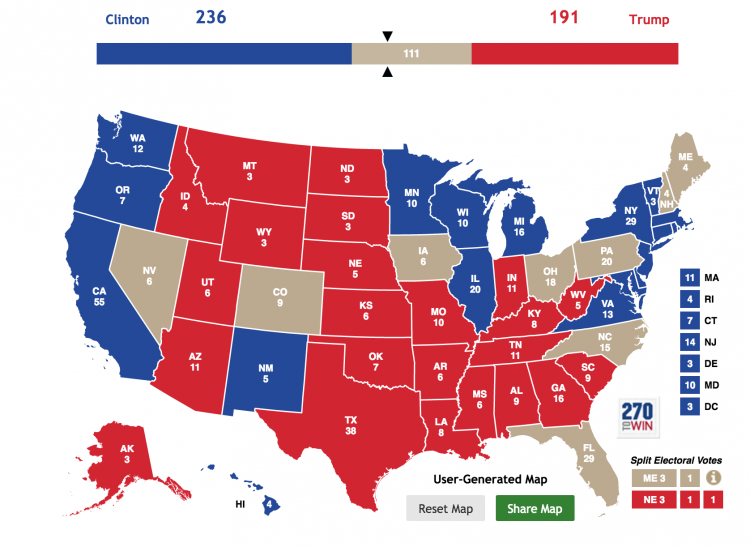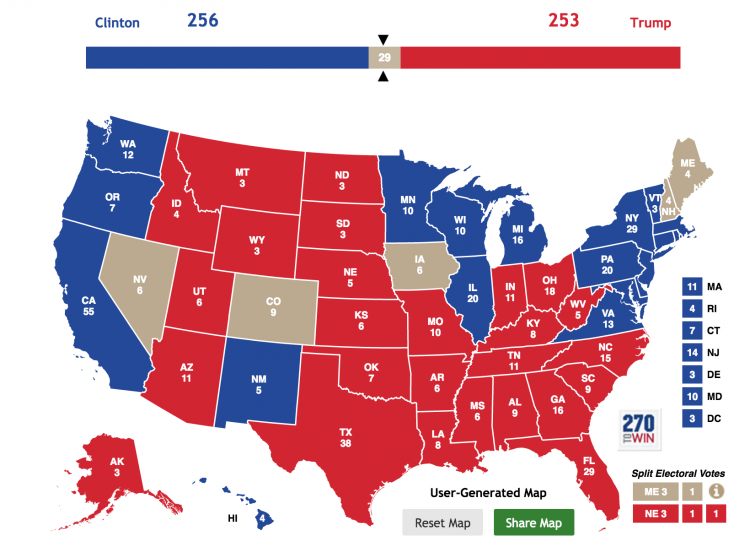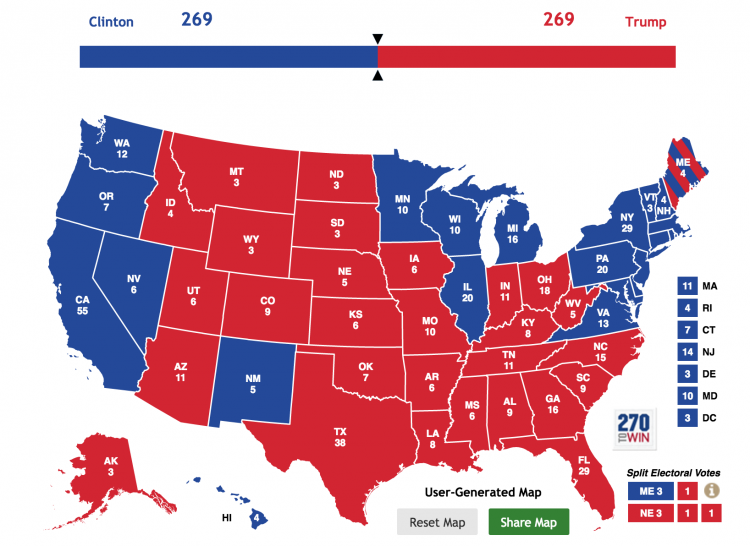
The Associated Press has a very cool interactive tool that allows you to see where Hillary Clinton and Donald Trump — and the various super PACs supporting or opposing them — are spending money on TV ads. Check it out here.
Using this tool, we gain a better understanding of the Trump campaign’s electoral strategy. While pro-Trump and anti-Clinton super PACs have been spending on TV ads for quite some time, the Trump campaign didn’t officially go on the air until the week of August 14.
Below is the Trump campaign’s TV ad spending by week:
- August 7 – August 13 ($0)
- August 14 – August 20 ($809,851)
- August 21 – August 27 ($3,121,608)
- August 28 – September 3 ($4,755,742)
- September 4 – September 10 ($7,310,402)
- September 11 – September 17 ($2,684,099)
- September 18 – September 24 ($516,441)
- September 25 – October 1 ($4,429,224)
Compare this to the Clinton campaign’s TV ad spending during the same time period:
- August 7 – August 13 ($12,962,027)
- August 14 – August 20 ($13,152,489)
- August 21 – August 27 ($10,988,130)
- August 28 – September 3 ($10,715,162)
- September 4 – September 10 ($14,075,985)
- September 11 – September 17 ($17,803,495)
- September 18 – September 24 ($19,522,217)
- September 25 – October 1 ($19,455,030)
Yikes. And remember, the Clinton campaign began spending on TV ads the week of May 15. All together, the Clinton campaign has spent $198.9 million on TV ads. The Trump campaign has spent just $23.6 million.
Additionally, the Associated Press tool allows you to see what spending has looked like in individual states. (It also allows you to view pro-Trump/pro-Clinton/anti-
The conventional wisdom pegs Pennsylvania as a must-win state for Donald Trump, which is why recent state polls — Monmouth has Clinton up 10 points, while Franklin & Marshall has Clinton up 9 points — have been very concerning. But check out the ad spending:
- September 11 – September 17 (Trump: $591,661; Clinton: $1,757,231)
- September 18 – September 24 (Trump: $2,835; Clinton: $2,515,133)
- September 25 – October 1 (Trump: $36,925; Clinton: $2,737,642)
One wonders whether the Trump campaign is even contesting Pennsylvania at all. More and more, it appears likely that Pennsylvania was a well-choreographed head fake by the Trump campaign in an attempt to divert Clinton resources to the Keystone State.
So where is Trump competing instead? Good question. He has consistently spent money in Ohio, Florida, and North Carolina, although his expenditures are still being dwarfed by Clinton and her super PAC allies. But look at his spending by state in the most recent reported week (September 25 – October 1):
- Florida: $1,624,562
- New Hampshire: $360,685
- Ohio: $329,081
- Nevada: $286,362
- North Carolina: $271,605
- Colorado: $247,140
- Iowa: $148,335
- Pennsylvania: $36,925
- Maine: $30,237
Based on that, I would argue there has been a strategy shift within the Trump campaign. Winning Pennsylvania is now a pipe dream, but the grass has proven greener in states like Colorado, New Hampshire, and Maine, three states most pundits previously marked firmly in Clinton’s column.
This is a workable strategy. Here’s what the electoral map looks like if you accept the premise that there are only nine swing states remaining:

In this scenario, Trump can afford to give up on Pennsylvania, but if he does, Ohio, Florida, and North Carolina become must-win states. Then his map looks like this:

With Clinton leading 256-253 with just Nevada (6), Colorado (9), Iowa (6), New Hampshire (4), and Maine (4) remaining, there are a number of ways Trump can win. Don’t forget, Maine allocates its electoral votes by congressional district — two votes go to the popular vote winner, one goes to the popular vote winner in ME-1, a Democrat-leaning district, and one goes to the popular vote winner in ME-2, a Republican-leaning district. The most likely allocation out of Maine, based on recent polling, appears to be 3 votes for one candidate and 1 for the other.
Let’s assume Trump wins Maine but loses one of the electoral votes to Clinton. Clinton would then lead 257-256. Trump would then need to win either a) Colorado and one of Iowa or Nevada (271-267 Trump), or b) Iowa, Nevada, and New Hampshire (272-266 Trump).
If Trump loses Maine but wins one of the electoral votes, Clinton would lead 259-254. In that scenario, the likelihood of an electoral tie becomes even more pronounced. If Trump wins Colorado and Iowa, while Clinton wins Nevada and New Hampshire, we would finish the night at 269-269.

The incoming state delegations in the U.S. House of Representatives would then vote on a president, and barring a Republican rebellion, that would result in Donald J. Trump serving as the 45th President of the United States.
The Trump campaign should be applauded for recognizing the difficulty of winning with a strategy dependent on Pennsylvania and shifting to an alternate strategy with a higher probability of electoral success. Let’s hope this move proves itself to be brilliant with a win in November.
Jon Schweppe is the Communications Director at American Principles Project.


